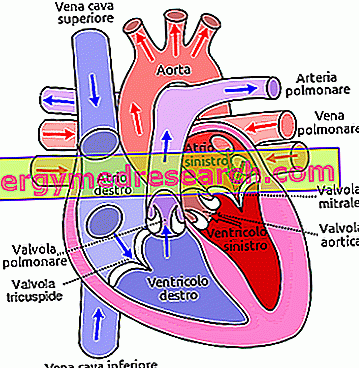Generality
Aortic stenosis (from the Greek στενόω, restrict) is a valvular heart disease, characterized by the narrowing or obstruction of the aortic valve (which regulates blood flow between the heart and the rest of the body). Rheumatic disease, senile degeneration and congenital malformations are the three main and most frequent causes of aortic stenosis. The symptoms are usually the consequence of the degree of narrowing of the valve: they become worse when the occlusion is greater. The first signs of aortic stenosis can be diagnosed by the doctor through a stethoscopic examination: a heart murmur may be the first indication of heart disease.

What is aortic stenosis. Pathophysiology
The aortic valve, also called aortic lunate valve, regulates the flow of arterial blood that is pumped from the heart to the rest of the body. It has the following characteristics:
- it is tricuspid, that is it is formed by three flaps, also called cusps. However, it should not be confused with the tricuspid valve proper (which regulates blood flow between the right atrium and the right ventricle);
- the three flaps, semi-lunar in shape and slightly offset, are arranged in such a way that the reflux of blood from the aorta into the ventricle is prevented;
- in a normal individual, the surface of the valve orifice varies between 2.5 and 3.5 cm2.
Obstruction in the aortic valve results in a reduction in efflux, or leakage, of blood from the left ventricle to the aorta and the systemic circulation. It will be clear, therefore, that greater narrowing of the aortic valve will have a more severe effect on cardiac activity. In fact, the first consequences of an aortic stenosis occur when the internal valve area is reduced by ¼ compared to normal, while the peak of gravity is reached when the orifice reaches to measure less than 0.75 cm2.
In the presence of an aortic stenosis, the heart must make a greater effort to pump the arterial blood, ie the oxygen-rich one, into the aorta. The consequences of this effort translate into a process of hypertrophy of the left ventricle.
A hypertrophic ventricle presents:
- Thick walls.
- Ventricular cavity unchanged, therefore smaller than the parietal structure.
Hypertrophy arises for the following reasons: the stenosis of the valve resists the outflow of blood from the left ventricle → the latter, therefore, with its contraction must develop a higher systolic pressure and for a longer time → the muscle fibers of the ventricle they therefore undergo a greater tension and are more stressed → the adaptive response of the heart to pressure overload (systolic overload) is the generation of new sarcomeres, the contractile units of striated muscle tissue, at the level of the ventricular walls → consequently, the walls of the left ventricle thicken by subtracting volume from the internal cavity, which can therefore accommodate less blood. But that's not all, in fact, ventricular hypertrophy hides further pitfalls:
- Systolic range is only apparently normal, as cardiac output does not change until the most advanced stages of heart disease. Therefore, at least initially, aortic stenosis is asymptomatic.
- The oxygen requirement of the myocardium increases, but it is not suitably supported by the coronary flow.
Types of aortic stenosis. The causes
Three different types of aortic stenosis can be distinguished. The distinction is based on the position of the obstacle opposite to the ventricular efflux.
- Valvular aortic stenosis.
- Cause: acquired
- Cause: congenital
- Subvalvular aortic stenosis, cause: congenital.
- Supravalvular aortic stenosis, cause: congenital.
The most common causes of acquired type are two and are due to:
- A rheumatic disease .
- A senile degeneration .
1. The rheumatic origin of aortic stenosis is attributable to a bacterial infection (usually of the airways) of type A beta-hemolytic streotococcus. The human body responds to this infection by producing antibodies, which help eradicate pathogens responsible. In some subjects, however, the antibody defenses produced against the streptococcus also recognize valvular cells as foreign and attack them. An inflammatory state is therefore created which leads to deformation of the aortic valve. The latter is thickened and presents the cusps merged with each other.
The rheumatic disease particularly affects young subjects (children) who live in poor hygienic conditions and in damp environments; not by chance, in industrialized countries, the disease has an ever smaller incidence.
2. In forms of stenosis due to advanced age, valve degeneration is caused by the deposition of calcium salts at the level of the cusps. The cusps therefore become rigid and the valve opening is more resistant to systolic contraction. It is a progressive degenerative process, whose critical outcome is around 65 years of age.
A congenital aortic stenosis deserves a separate chapter. It is, in fact, a very broad topic and we will limit ourselves, for now, to give a description of the most important features. The congenital adjective indicates that the valve defect is present from birth, or that there is a predisposition to develop it. The congenital form of aortic stenosis may occur at the valvular, subvalvular and supravalvular level, depending on whether the aortic valve or the portions adjacent to it are modified from birth.
In particular, congenital valvular aortic stenosis consists of a modification of the cusps that make up the valve. The latter can be bicuspid, asymmetric tricuspid or monocuspid. Those who are affected, generally have a family member with the same defect. Therefore, there is a genetic component.
Symptoms and possible complications
When the narrowing of the aortic valve is still mild, the individual with aortic stenosis has no obvious symptoms. A first sign is the random relief of a heart murmur after stethoscopic examination. When, on the other hand, the narrowing begins to get larger, the affected subject manifests three characteristic symptoms:
- Dyspnea on exertion.
- Angina pectoris.
- Stress Syncope.
Stress dyspnea, that is difficult breathing, is the most frequent symptom. It is the consequence of the lower outflow of blood from the left ventricle. The heart struggles to pump oxygenated blood to the tissues, therefore, the answer is to increase the number of breaths; respiratory acts that are however difficult, due to the valve narrowing. Furthermore, as the circulatory flow is hindered, there is an accumulation of blood in the pulmonary veins. Imagine a dam that continuously takes water, without being able to discharge it. This stagnation can result in the compression of the respiratory tract and, in the most serious cases, in the leakage of blood from the vessels towards the alveoli. This condition is pulmonary edema: in these conditions, the exchange between oxygen and carbon dioxide from the alveolus to the blood is compromised.
Angina pectoris is typical of severe aortic stenosis. By severe, we mean a serious pathological condition. The triggering cause is related to myocardial hypertrophy at the ventricular level. A hypertrophic myocardium requires more oxygen, but the coronary flow, in this case, is not able to "feed" a larger and "hungry" ventricle of oxygen and nutrients. There is therefore no occlusion of the coronary vessels, but only an imbalance between consumption and oxygen supply. Angina pectoris occurs with chest pain.
Syncope is the natural consequence of a compromised outflow of blood from the left ventricle. In fact, syncope occurs when blood flow to brain tissue is reduced. The obstruction, at the valvular level, prevents the normal circulation of the brain tissue and this condition can manifest itself either during an effort, or physical activity, or, more serious eventuality, at rest. Syncope at rest is often associated with a malfunction of the left ventricle and can cause sudden death.
Finally, if the shrinkage reaches critical levels, the risk of cardiac arrest, or heart attack, is very high. This is mainly due to a serious imbalance between the oxygen consumption of the hypertrophic ventricle and the coronary intake. If not adequately sprayed, the heart cells undergo necrosis.
Diagnosis
An aortic stenosis can be detected by the following diagnostic tests:
- Stethoscopy.
- Electrocardiogram (ECG).
- Echocardiography.
- Thoracic radiography.
- Cardiac catheterization.
Stetoscopy . Detection, even random, of a systolic murmur may be the first clue to diagnose aortic stenosis. The systolic murmur occurs when the blood passes through the stenotic valve (restricted). The detection zone is between the II and III intercostal space, to the right and to the left of the sternum. It is also possible that the breath may radiate along the arteries of the neck.
ECG . By measuring the electrical activity of the heart, the electrocardiogram shows hypertrophy and systolic overload of the left ventricle. Diagnosis by ECG gives an idea of the degree of severity of aortic stenosis: the greater the extent of hypertrophy and systolic overload, the greater the severity of heart disease.
Echocardiography . Taking advantage of the ultrasound emission, this diagnostic tool shows, in a non-invasive way, the fundamental elements of the heart: atriums, ventricles, valves and surrounding structures. From echocardiography, the doctor can detect:
- Abnormalities or changes in cusps.
- Anatomical anomalies of the efflux pathway, ie the valvular orifice.
- Increased thickness of the left ventricular walls, but unchanged ventricular cavity size.
- The maximum flow rate, through the use of the Doppler. From this measurement, the pressure values between left ventricle and aorta can be derived.
Chest x-ray . It is useful for identifying valvular calcifications, which almost always correspond to a severe aortic stenosis.
Cardiac catheterization . It is an invasive hemodynamic technique. In fact, it involves the use of catheters to reach the heart through the venous and arterial vessels. The route and the survey of the catheters are followed on a special screen. The extent of blood flow through the aortic valve is measured and, based on this data, it is possible to go back to the size of the valve area. In other words, it is possible to have a precise datum about the dimensions of the valve orifice. As we have seen, the normal size measures approximately 3 cm2; while a value less than 1 cm2 is indicative of a severe stenosis. The technique serves to confirm the diagnosis, to specify the site of the valve anomaly and the severity of the stenosis; moreover, it is useful to exclude or not a possible associated heart disease.
Treatment
The choice of treatment in patients suffering from aortic stenosis depends, first of all, on the severity of the stenosis itself. In fact, surgery is the only procedure that can resolve the valve anomaly. Despite the current techniques, they now have a good chance of success, it is a delicate intervention, which must, in any case, be considered. In fact, it is essential to carry out a complete instrumental diagnosis, as there may be cases of asymptomatic aortic stenosis, but serious, for which the intervention is a must, or opposite cases, in which the stenosis is not serious, but has obvious symptoms linked to other causes that would make you think otherwise. In the latter circumstance, the patient's situation must be monitored over time, but does not require immediate intervention. The possible surgical operations are:
- Valvulotomy . This is a direct surgical intervention on the valve. It is a technique almost completely abandoned. It is practiced, in some cases, on children with congenital aortic stenosis.
- Aortic valve replacement with a mechanical or biological prosthesis.
- Valvuloplasty . Stenosis is reduced with the use of balloon catheters, thus adjusting the altered ventricular pressure and ensuring a better blood flow. It is indicated in children.
Pharmacological treatment is indicated for symptom control, for short periods of time and following certain surgical operations. The drugs commonly used are:
- ACE inhibitors . They are inhibitors of the enzyme system that converts angiotensin. They are used to reduce the ventricular pressure, raised as a result of the difficulties encountered by the heart in pumping blood through a stenotic valve. They are hypotensive drugs.
- Diuretics . They are also hypotensive drugs.
- Antibiotics . They are administered to the patient subjected to valve replacement with a prosthesis. They are used to prevent endocarditis. An endocarditis is a bacterial infection of the internal cavities of the heart. In this regard, oral hygiene and dental health should be recommended. If neglected, in fact, they can develop, in the patient suffering from aortic stenosis, bacterial infections with a more serious outcome than a healthy individual.



